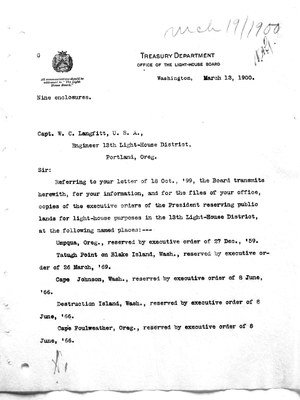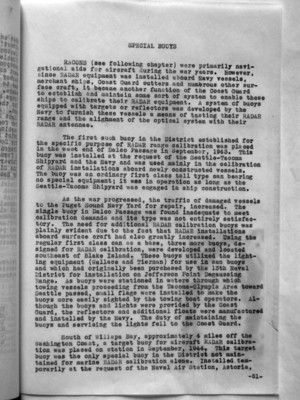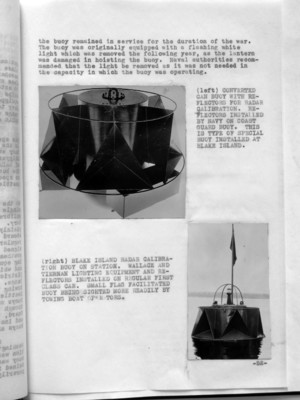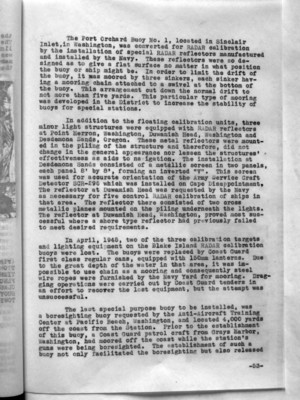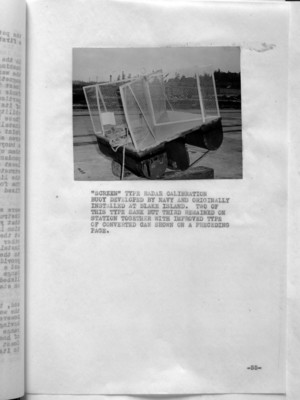Pages That Mention Blake Island
Box 247 1899 to 1900 JA land 4000 app 1866 reserved
7
All communications should be addressed to "The Light-House Board."
Treasury Department Office of the Light-House Board Washington, March 13, 1900
Nine enclosures.
Capt. W.C. Langfitt, U.S.A., Engineer 13th Light-House District, Portland, Oreg.
Sir:
Referring to your letter of 18 Oct., '99, the Board transmits herewith, for your information, and for the files of your office, copies of the executive orders of the President reserving public lands for light-house purposes in the 13th Light-House District, at the following named places: --
Umpqua, Oreg., reserved by executive order of 27 Dec., '59. Tatugh Point on Blake Island, Wash., reserved by executive order of 25 March, '69. Cape Johnson, Wash., reserved by executive order of 8 June, '66. Destruction Island, Wash., reserved by executive order of 8 June, '66. Cape Foulweather, Oreg., reserved by executive order of 8 June, '66.
Coast Guard District narrative histories 1945
71
SPECIAL BUOYS
RACONS (see following chapter) were primarily navigational aids for aircraft during the war years. However, since RADAR equipment was installed aboard Navy vessels, merchant ships, Coast Guard cutters and numerous other surface craft, it became another function of the Coast Guard to establish and maintain some sort of system to enable these ships to calibrate their RADAR equipment. A system of buoys equipped with targets or reflectors was developed by the Navy to furnish these vessels a means of testing their RADAR range and the alignment of the optical system with their RADAR antennae.
The first such buoy in the District established for the specific purpose of RADAR range calibration was placed in the west end of Dalco Passage in September, 1943. This buoy was installed at the request of the Seattle-Tacoma Shipyard and the Navy and was used mainly in the calibration of RADAR installations aboard newly constructed vessels. The buoy was an ordinary first class tall type can bearing no special equipment; it was in operation as long as the Seattle-Tacoma Shipyard was engaged in ship construction.
As the war progressed, the traffic of damaged vessels to the Puget Sound Navy Yard for repair, increased. The single buoy in Dalco Passage was found inadequate to meet calibration demands and its type was not entirely satisfactory. The need for additional RADAR calibration buoys was plainly evident due to the fact that RADAR installations aboard surface craft had also greatly increased. Using the regular first class can as a base, three more buoys, designed for RADAR calibration, were developed and located southeast of Blake Island. These buoys utilized the lighting equipment (Wallace and Tiernan) for use in can buoys and which had originally been purchased by the 13th Naval District for installation on Jefferson Point Degaussing Range. As buoys were stationed in waters through which towing vessels proceeding form the Tacoma-Olympia Area toward Seattle passed, small flags were installed to make the buoys more easily sighted by the towing boat operators. Although the buoys and lights were provided by the Coast Guard, the reflectors and additional floats were manufactured and installed by the Navy. The duty for maintaining the buoys and servicing the lights fall to the Coast Guard.
South of Willapa Bay, approximately 4 miles off the Washington Coast, a target buoy for aircraft RADAR calibration was placed on station in September, 1944. This target buoy was the only special buoy in the District not maintained for marine RADAR calibration alone. Installed temporarily at the request of the Naval Air Station, Astoria,
-51-
72
the buoy remained in service for the duration of the war. The buoy was originally equipped with a flashing white light which was removed the following year, as the lantern was damaged in hoisting the buoy. Naval authorities recommended that the light be removed as it was not needed in the capacity in which the buoy was operating.
(image)
(left) CONVERTED CAN BUOY WITH RE FLECTORS FOR RADAR CALIBRATION. RE FLECTORS INSTALLED BY NAVY ON COAST GUARD BUOY. THIS IS TYPE OF SPECIAL BUOY INSTALLED AT BLAKE ISLAND.
(image)
(right) BLAKE ISLAND RADAR CALIBRA TION BUOY ON STATION. WALLACE AND TIERNAN LIGHTING EQUIPMENT AND RE FLECTORS INSTALLED ON REGULAR FIRST CLASS CAN. SMALL FLAG FACILITATED BUOY BEING SIGHTED MORE READILY BY TOWING BOAT OPERATORS.
-52-
73
The Port Orchard Buoy No. 1, located in Sinclair Inlet, in Washington, was converted for RADAR calibration by the installation of special RADAR reflectors manufactured and installed by the Navy. These reflectors were so designed as to give a flat surface no matter in what position the buoy or ship might be. In order to limit the drift of the buoy, it was moored by three sinkers, each sinker having a mooring chain attached to a swivel at the bottom of the buoy. This arrangement cut down the normal drift to not more than five yards. This particular type of mooring was developed in the District to increase the stability of buoys for special stations.
In addition to the floating calibration units, three minor light structures were equipped with RADAR reflectors at Point Herron, Washington, Duwamish Head, Washington and Desdemona Sands, Oregon. These metal reflectors were mounted in the piling of the structure and therefore, did not change in the general appearance nor lessen the structures' effectiveness as aids to navigation. The installation at Desdemona Sands consisted of a metallic screen in two panels, each panel 8' by 8', forming an inverted "V". This screen was used for accurate orientation of the Army Service Craft Detector SCR-296 which was installed on Cape Disappointment. The reflector at Duwamish Head was requested by the Navy as necessary for five control RADAR calibration of ships in that area. The reflector there consisted of two cross metallic planes mounted on the piling underneath the lights. The reflector at Duwamish Head, Washington, proved most successful where a shore type reflector had previously failed to meet desired requirements.
In April, 1945, two of the three calibration targets and lighting equipment on the Blake Island RADAR calibration buoys were lost. The buoys were replaced by Coast Guard first class regular cans, equipped with 150mm lanterns. Due to the great depth of the water in that area, it was impossible to use chain as a mooring and consequently steel wire ropes were furnished by the Navy Yard for mooring. Dragging operations were carried out by Coast Guard tenders in an effort to recover the lost equipment, but the attempt was unsuccessful.
The last special purpose buoy to be installed, was a boresighting buoy requested by the Anti-Aircraft Training Center at Pacific Beach, Washington, and located 4,000 yards off the coast from the Station. Prior to the establishment of this buoy, a Coast Guard patrol craft from Grays Harbor, Washington, Had moored off the coast while the station's guns were being boresighted. The establishment of such a buoy not only facilitated the boresighting but also released
-53-
75
(image)
"SCREEN" TYPE RADAR CALIBRATION BUOY DEVELOPED BY NAVY AND ORIGINALLY INSTALLED AT BLAKE ISLAND. TWO OF THIS TYPE SANK BUT THIRD REMAINED ON STATION TOGETHER WITH IMPROVED TYPE OF CONVERTED CAN SHOWN ON A PRECEDING PAGE.
-55-
